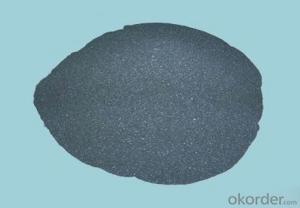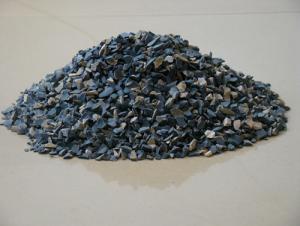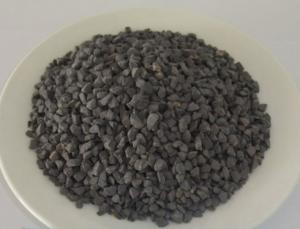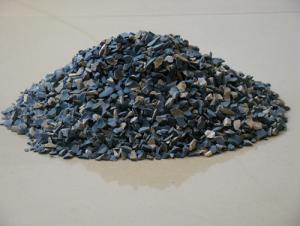Refractory Raw Materials-Silicon Powder Materials
- Loading Port:
- Tianjin
- Payment Terms:
- TT OR LC
- Min Order Qty:
- 20 m.t.
- Supply Capability:
- 1000 m.t./month
OKorder Service Pledge
OKorder Financial Service
You Might Also Like
Aggregate for high-quality refractory materials (shaped and non-shaped) for the steel, foundry , and glass industry.
Meanwhile, WFA could be used for Ceramic field
Size: 0-1mm, 1-3mm, 3-5mm.... such phase sand
0-10mm; 0-30mm................such block sand
220mesh, 325mesh............such fine powder
Specification
Al2O3 Fe2O3 SiO2 Na2O B.D.
99.2%Min 0.1% Max 0.2% Max 0.3% Max 3.7g/cm3 Min
In the same condition, using manganese or silicon to deoxidize separately, the burn out rate are 46% and 37%, but it is only 29% if using manganese alloy to deoxidize. So, it is used widely to smelting steel and its output increases faster than ferroalloy's, so has become an indispensable composite deoxidizing and alloy additives in steel industry. The silicon-manganese which contains carbon below 1.9% still is used to produce medium/low-carbon ferromanganese and semi-finished products of electro silicothermic process manganese metal.
- Q:What things and cement mixed can act as refractory?
- Cement building, portland cement, refractory grade, calcium aluminate. Cement acts as refractory need to use calcium aluminate cement.
- Q:Does refractory belong to stone, building materials or other?
- It belongs to building materials.
- Q:What's the classification of flameproof glass, the refractory time of fireproofing glass.
- who knows the classification of fireproofing glasses, how long is the fire-resistant time?
- Q:What's the fire resistance rating of the exterior fire?retardant?coating?
- First of all, fire retardant coating has no class distinctions. Buildings fire resistance rating is generally classified as follows: I grade fire resistance, II grade fire resistance, III grade fire resistance, IIII grade fire resistance. Buildings with I grade and II grade fire resistance are much common. According to the coating thickness, exterior fire-resistant coating for steel structure can be classified as follows: 1. Exterior thin fire-resistant coating for steel structure, 2. Exterior ultra-thin fire-resistant coating for steel structure, 3. Exterior thick fire-resistant coating for steel structure.
- Q:What's the commonly used refractory material for ladle?
- 1. According to the refractoriness, it can be classified as follows: common refractory: 1580℃ ~ 1770℃; high grade refractory: 1770℃ ~ 2000℃; superrefractory: 2000 ℃; 2. According to the shape and demension of the product, it can be classified as follows: standard form : 230mm×113mm ×65mm of no more than four measuring scale, (demension ratio) Max: Min
- Q:What is the new fireproofing standard of external wall thermal insulation materials?
- 1, The height of fire barrier zone is not less than 300, and the thickness is same to the external insulation system; 2, the horizontal dividing joint should be set on the boundary between fire barrier zone and thermal insulation system; 3, Fire barrier zone is usually set in the horizontal direction, the fire barrier zone should be set above the door and window openings, the distance between the low edge of barrier zone and upward side of the hole should not exceed 500mm; 4, The construction of fire barrier zone insulating layer should carried on from bottom to top with EIFS insulating layer, which is not first leave the place in the EIFS insulating layer, and then paste fire barrier zone insulation board; 5, pasting the insulation board fire barrier zone insulation board and EIFS insulation board should be stitched closely, the width is more than 2mm gap application EIFS insulation materials or fire-retardant foam polyurethane padding;
- Q:Firing high temperature kiln of refractory and internal temperature being as high as 1600 ℃, metal heat exchanger can't use, how to do?
- 1>3>。 When metal heat exchanger is in 700 ℃, it must process high temperature protection, mixed cold wind or cold blast to protect heat exchanger. So this will waste a lot of energy; The comparison of high temperature resistant ceramic heat exchanger using temperature is 1350 ℃ to 1450 ℃; metal heat exchanger using temperature 700 ℃; heat utilization comparison of ceramic heat exchanger can be placed in 1350 ℃ or higher (highest available to 1450 ℃); the oxidation resistance, a very short time will burn out;2 >, waste heat recovery rate is high. Replacing the metal heat exchanger in high temperature and corrosion environment; Comparative ceramic heat exchanger can be used under the condition of 1350 ℃ for a long time. Let's make a comparison, if it is a refractory material industry. <, ceramic heat exchanger is simply won't appear, under the condition of equal to ceramic heat exchanger using, energy saving effect is best, can exchange for the high temperature. <. Ceramic heat can be placed on the nearest of exchanger flue outlet . <, and metal heat exchanger put in place contrast to the ceramic heat exchanger. In the process of using metal heat exchanger, if this situation happens, you can consider the ceramic heat exchanger. Temperature difference is between 650 ℃ to 750 ℃. If the metal heat exchanger is placed in normal place where ceramic heat usually put;The service life comparison: since ceramic heat exchanger with high temperature resistance, this partly replace metal heat exchanger. What's more, energy-saving rate is also different. Metal heat exchanger can be placed in 700 ℃ or less;4 >, corrosion resistance, its application effect is very different. So the metal-heat-exchanger's heat-resistant temperature is high and the service life is the countless times of metal heat exchanger. The place with highest temperature does not need high temperature protection.
- Q:I would like to know if there is any requirement for refractories in the crucible type high-frequency smelting furnace Worry! I hope you can help me! This time!
- Good thermal stability, the crucible wall hour working temperature fluctuation is great, and the temperature field distribution is uneven, so the crucible wall will continue to produce volume expansion and contraction, resulting in cracks, which directly affect the service life of the crucible
- Q:What are some of the new refractories and what are their characteristics?
- Refractory common AZS refractories are often used brick, corundum brick, magnesia chrome brick, silicon carbide, silicon nitride bonded silicon carbide, nitrides, silicides, sulfide, boride, carbide and other non oxide refractory materials; calcium oxide, chromium oxide, aluminum oxide, beryllium oxide and other refractory materials, Magnesium Oxide
- Q:What is the difference between the fire?rating and the fire resistant level of the fire-fighting equipment?
- Fire rating and fire-fighting rating are the misnomer to the building fire resistant level. The building fire risk is measured by fire resistant level. The article 3.2.1 and 5.1.7 of "Architectural design code for fire protection" have made provision respectively on the fire resistant level of plant (the storeroom) and civil construction. Article 3.0.2 of "Code for fire protection design of tall buildings" has made provisions on the fire resistant level of tall buildings. As for the warehouse building "category malonate", it refers to one of the fire risk of goods storage, which is divided into A, B, C, D, E, and each category is refined depending on the nature of different substances. "Malonate class" specified in article 3.1.3 of "building design for fire protection" refers to the flammable solid.
1. Manufacturer Overview |
|
|---|---|
| Location | |
| Year Established | |
| Annual Output Value | |
| Main Markets | |
| Company Certifications | |
2. Manufacturer Certificates |
|
|---|---|
| a) Certification Name | |
| Range | |
| Reference | |
| Validity Period | |
3. Manufacturer Capability |
|
|---|---|
| a)Trade Capacity | |
| Nearest Port | |
| Export Percentage | |
| No.of Employees in Trade Department | |
| Language Spoken: | |
| b)Factory Information | |
| Factory Size: | |
| No. of Production Lines | |
| Contract Manufacturing | |
| Product Price Range | |
Send your message to us
Refractory Raw Materials-Silicon Powder Materials
- Loading Port:
- Tianjin
- Payment Terms:
- TT OR LC
- Min Order Qty:
- 20 m.t.
- Supply Capability:
- 1000 m.t./month
OKorder Service Pledge
OKorder Financial Service
Similar products
New products
Hot products
Hot Searches
Related keywords



























